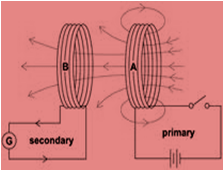Question 4: Explain the phenomenon of mutual induction. Define the coefficient of mutual induction and units?
ANSWER
Mutual Induction
The effect which results in an emf in one circuit due to a changing current in the other circuit is called mutual inductance.

Explanation of Mutual Induction
Consider two coils A and B as shown in the figure. The primary coil A is connected to a source of varying current (Alternating current or a battery with a rheostat) whereas the secondary coil is connected to a sensitive galvanometer. The two coils are placed near. The current through the primary coil is started, stopped or changed by changing the resistance of the rheostat if it is not an alternating current. This change of current will change the magnetic flux through the secondary coil, inducing emf in it which, by Faraday’s law, is proportional to the rate of change in the primary coil.

If there are N turns in the coil, the flux linkages are Nф which is proportional to the current I. Therefore,

Now Nф ∝. Use this in the above equation,

Coefficient of Mutual Induction
In the above equation, M is the constant of proportionality, called the mutual inductance of the two coils and the negative sign is taking into account the Lenz Law.
The equation may be reduced to the form,

This defines coefficient of mutual inductance M as the ratio of emf induced in the second coil to the time rate of change of current in the primary coil
Do you know “coefficient” means a constant which is a measure of a physical quantity under specific conditions?
The specific conditions here are geometrical shape, no of turns in both coils etc etc.
The value of M depends on the geometrical features of the pair of the coils including number of turns in both coils, the cross-sectional area of the coils, separation between them and the presence of iron (core) between the coils.
Unit of Mutual Induction
Unit of M is henry and equal to the volt-second per ampere. It is defined as the mutual inductance of two coils is one henry, if current changing at the rate of one ampere per second in the primary causes an induced emf of one volt in the secondary.
Comprehension Time
(1) When the current in the primary circuit is decreased, there is a change in the magnetic flux linking the secondary coil and an emf is induced in it. What is the direction of the induced emf?
(2) When the current in the primary circuit is increased, what is the direction of induced emf in the secondary?

Pingback:Comprehensive Questions on Electromagnetic Induction, Physics 12 … msa – msa
Pingback:self-inductance-and-its-coefficient – msa
Pingback:lenz-law – msa